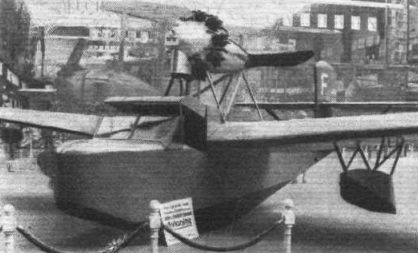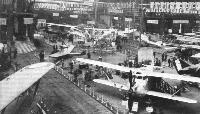Liore-et-Olivier H-18
Спроектированный Бенуа и Риффром, самолет Liore-et-Olivier H-18 (или H-180) представлял собой небольшой свободнонесущий моноплан. Это была летающая лодка с высокорасположенным крылом и силовой установкой Salmson 9Ac мощностью 120 л. с., установленный над корпусом и работавший на толкающий воздушный винт. В открытой кабине располагались бок о бок два пилота, самолет был облетан в начале 1928 года. В 1929 году самолет прошел модернизацию - получил закрытую кабину и был переименован в H-181. Планировалось построить 10 машин, но удалось собрать только пять - одну отправили в США, где она потерпела крушение, а остальные не нашли покупателей и были возвращены во Францию, где использовались в качестве опытных самолетов. H-181 имел крыло размахом 12,55 м и развивал скорость до 165 км/ч.
Показать полностьюShow all
Liore-et-Olivier H-23 и H-23-2
LeO H-23 был разработан компанией "Liore-et-Olivier" под требования ВМС Франции от 1928 года на одномоторный самолет-амфибию для прибрежного патрулирования. Он представлял собой свободнонесущий деревянный моноплан с высокорасположенным крылом и закрытой пилотской кабиной, а также расположенными в носовой части и в центре стрелковыми установками. Два опытных самолета были заказаны, но в воздух поднялся только один - в начале 1930 года. Самолет оснащался двигателем Hispano-Suiza 12N в 600 л. с., установленным над корпусом.
LeO H-23 продемонстрировал максимальную скорость 200 км/ч, однако вскоре он потерпел крушение. Впрочем, следом построили H-23-2 с двигателем Hispano-Suiza 12Nbr, установленным на верхнем крыле. Опытный самолет H-23-2.01 имел усиленную конструкцию для применения с катапульт, он рассматривался как разведывательный. Опытный самолет совершил первый полет в начале 1932 года. Три серийных самолета в 1934 году были поставлены Венесуэле, они имели открытые кабины для двух летчиков перед крылом, а также получили две стрелковые точки в носовой части и в центре фюзеляжа. Их максимальная скорость составляла 210 км/ч.
Показать полностьюShow all
Flight, July 1928
THE PARIS AERO SHOW 1928
The LeO H.18
Although the square section, flat-bottomed single-step hull might not be viewed with favour in this country, the Liore land Olivier LeO H.18 is a very interesting little machine and represents a type which, in our opinion, deserves to be taken up and developed for the British private owner, who prefers to make use of the many rivers, lakes and other sheltered waters which offer good anchorages and are suitable for use as "aerodromes."
Comfort has obviously been one of the aims of the designer in producing this machine, for he has placed pilot and passenger side by side in a fairly wide compartment, ahead of the wing and in front of the engine. Moreover, he has provided them with a hinged windowed roof so that in bad weather they may be protected against the elements. In coming in to pick up moorings, the occupants can raise this roof, when they are free to wield boat hook and mooring rope. The fact that the engine is above and behind the cockpit, and drives a "pusher" airscrew, further enables the machine to be taxied along slowly when picking up moorings, leaving the crew free to manoeuvre without having to stop the engine until the machine has been secured.
Except for cheapness, there is, of course, no reason why the hull should not be made with two steps and V-planing bottom, as in large British flying boats. Seaworthiness would scarcely be expected from so small a craft, whatever hull form is chosen, but the V-bottom is a great help in reducing the shock of alighting, even on a smooth surface.
In the LeO H.18 the hull is of all-wood construction, as is also the monoplane wing, which is covered with plywood. Lateral stability on the water is ensured by two wing floats.
<...>
Показать полностьюShow all
Flight, June 1929
OLYMPIA AERO SHOW 1929
The LeO H.18
The firm Liore and Olivier exhibits the little two-seater flying-boat LeO H.18, which was shown at the last Paris Aero Salon. This machine, intended for training seaplane pilots, has been designed for extreme simplicity in construction and maintenance. The boat hull, of plywood, the wooden one-piece wing, also covered with plywood, and the complete engine unit are all easily detached and erected. Thus, the wing is secured to the hull by four bolts only, while the engine unit, complete in itself, is also attached to the wing by four bolts. The unit system is extended to the controls, which are again secured by four bolts.
The hull is of the flat-bottomed variety, and of fairly large beam so that the two occupants, pilot and pupil, are seated side by side. If desired, the cockpit can be covered over with a cabin roof. The hull is divided into a number of watertight compartments, and as the wooden monoplane wing is also watertight, it is held that the machine should be practically unsinkable.
The main dimensions of the LeO H.18 are: Length, 7-44 m. (24-4 ft.); wing span, 12-55 m. (41-2 ft.); wing area, 21-1 sq. m. (227 sq. ft.); weight empty, 676 kg. (1,490 lbs,); weight of fuel (for three hours), 74 kg. (163 lbs.); useful load, 180 kg. (396 lbs.). Total loaded weight, 930 kg. (2,049 lbs.).
The engine fitted is a 120 h.p. Salmson, but other power plants of similar power may be fitted instead. With this engine the performance is: Full speed, 165 km./h. (102 m.p.h.); cruising speed, 140 km./h. (87 m.p.h.); climb to 6,600 ft. in 20 mins.; service ceiling, 3,500 m. (11,500 ft.); range, 520 km. (320 miles).
Показать полностьюShow all
Flight, December 1930
The PARIS AERO SHOW
LIORE AND OLIVIER
<...>
Another machine exhibited on this stand is a cantilever monoplane flying boat, the LeO H.22. This can be equipped either for touring (pilot and 3 passengers), or for air mail transport. It is a much smaller machine than the H.27 and has a metal planked hull and plywood-covered wing. The engine, a Gnome-Rhone "Titan," is mounted as a pusher on a three-legged mounting above the hull. The LeO H.22 is an amphibian, the land undercarriage being arranged in a manner not unlike that used on the Short "Mussel."
Показать полностьюShow all








